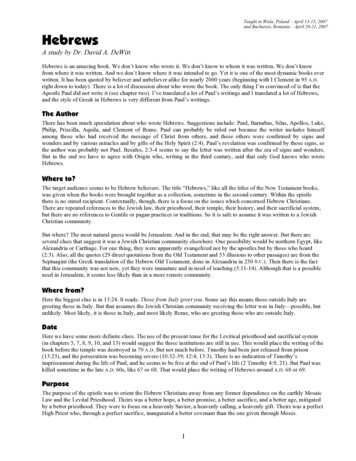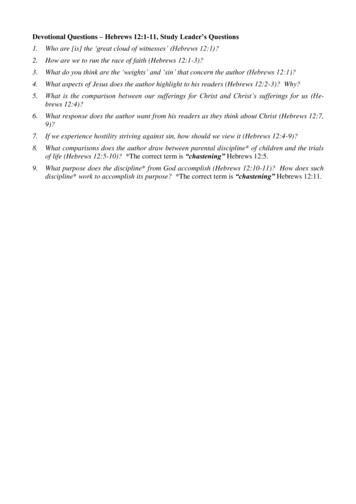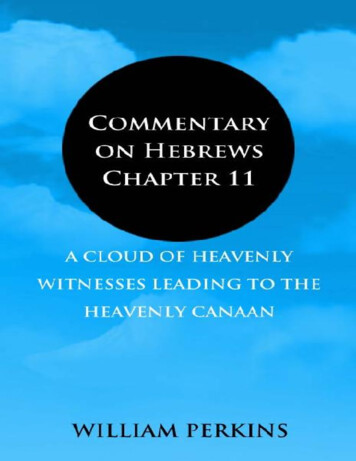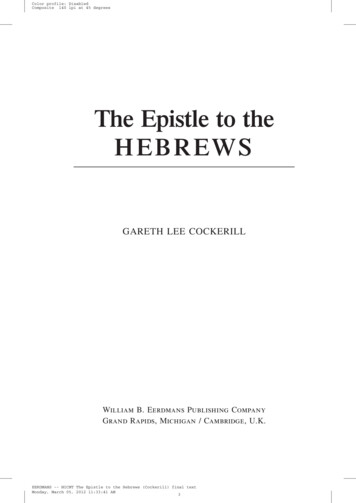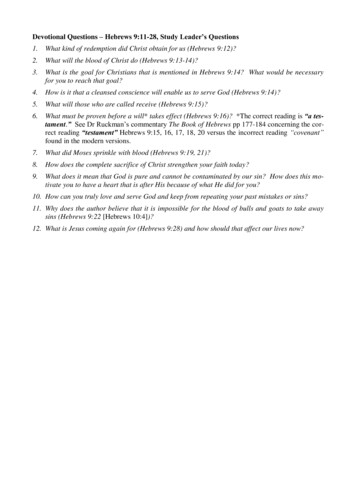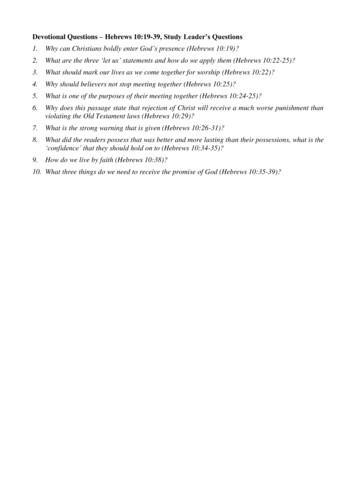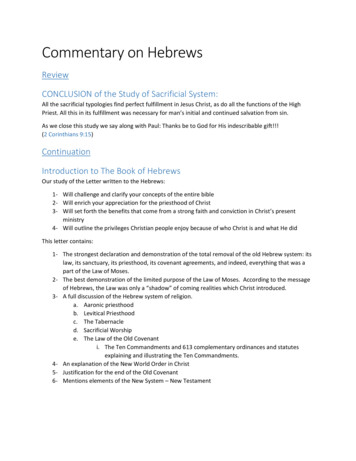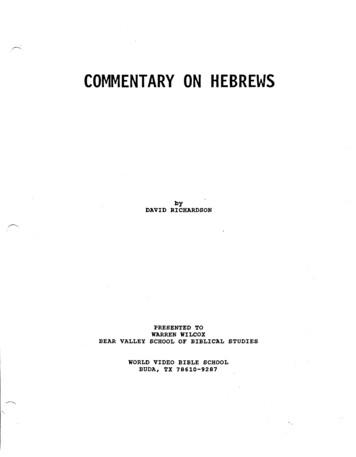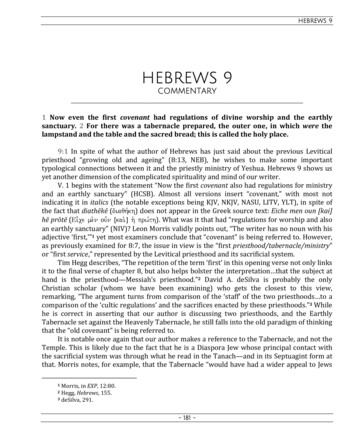
Transcription
HEBREWS 9HEBREWS 9COMMENTARY1 Now even the first covenant had regulations of divine worship and the earthlysanctuary. 2 For there was a tabernacle prepared, the outer one, in which were thelampstand and the table and the sacred bread; this is called the holy place.9:1 In spite of what the author of Hebrews has just said about the previous Leviticalpriesthood “growing old and ageing” (8:13, NEB), he wishes to make some importanttypological connections between it and the priestly ministry of Yeshua. Hebrews 9 shows usyet another dimension of the complicated spirituality and mind of our writer.V. 1 begins with the statement “Now the first covenant also had regulations for ministryand an earthly sanctuary” (HCSB). Almost all versions insert “covenant,” with most notindicating it in italics (the notable exceptions being KJV, NKJV, NASU, LITV, YLT), in spite ofthe fact that diathēkē (diaqh,kh) does not appear in the Greek source text: Eiche men oun [kai]hē prōtē (Ei ce me.n ou n Îkai.Ð h prw,th). What was it that had “regulations for worship and alsoan earthly sanctuary” (NIV)? Leon Morris validly points out, “The writer has no noun with hisadjective ‘first,’”1 yet most examiners conclude that “covenant” is being referred to. However,as previously examined for 8:7, the issue in view is the “first priesthood/tabernacle/ministry”or “first service,” represented by the Levitical priesthood and its sacrificial system.Tim Hegg describes, “The repetition of the term ‘first’ in this opening verse not only linksit to the final verse of chapter 8, but also helps bolster the interpretation that the subject athand is the priesthood—Messiah’s priesthood.”2 David A. deSilva is probably the onlyChristian scholar (whom we have been examining) who gets the closest to this view,remarking, “The argument turns from comparison of the ‘staff’ of the two priesthoods to acomparison of the ‘cultic regulations’ and the sacrifices enacted by these priesthoods.”3 Whilehe is correct in asserting that our author is discussing two priesthoods, and the EarthlyTabernacle set against the Heavenly Tabernacle, he still falls into the old paradigm of thinkingthat the “old covenant” is being referred to.It is notable once again that our author makes a reference to the Tabernacle, and not theTemple. This is likely due to the fact that he is a Diaspora Jew whose principal contact withthe sacrificial system was through what he read in the Tanach—and in its Septuagint form atthat. Morris notes, for example, that the Tabernacle “would have had a wider appeal to JewsMorris, in EXP, 12:80.Hegg, Hebrews, 155.3 deSilva, 291.12- 181 -
HEBREWS FOR THE PRACTICAL MESSIANICthan the temple had. The temple was accessible only to those in Jerusalem; but wherever Jewswere, their Scriptures told them all about the tabernacle.”4Contrary to the widespread idea that our author is demeaning the Tabernacle service,the author of Hebrews actually holds it in high esteem. Donald Guthrie explains, “He isimpressed by the orderliness of the arrangements within the Levitical cultus, and aims topresent this in order to demonstrate the greater glory of the new.”5 In other words, our writerrelies upon his audience’s nostalgia for the Tabernacle and its priestly implements to showthem how more profound the priestly work of Yeshua the Messiah is. The term he employs todescribe its “regulation” is dikaiōma (dikai,wma), meaning “an action that meetsexpectations as to what is right or just, righteous deed” (BDAG).6Our author’s main appeal is to the original Tabernacle, which would have been muchmore authoritative for his broad audience, as some likely considered the Second Temple to benothing more than a sign of a corrupt Saddusaical priesthood. Yet, in spite of the Tabernaclebeing a sign of presumably simpler times, before the Temple was constructed, it is stillkosmikos (kosmiko,j) or “of this world, earthly” (LS).7 The “earthly sanctuary” is inferior to theHeavenly one where Yeshua presently serves.9:2 What the NASU describes as “a tabernacle prepared, the outer one” is actually skēnēgar kateskeuasthē hē prōtē (skhnh. ga.r kateskeua,sqh h prw,th), or “a tabernacle was prepared,the first” (YLT), describing the first chamber of the Ancient Hebrews’ Tabernacle. Our authorwill describe how the Tabernacle was prepared, demonstrating an innate knowledge of notonly what the Tanach says, but also of contemporary Jewish traditions of his time. He willshow the incomplete nature of the Levitical priesthood and how Yeshua’s priesthood can onlybring complete redemption. In spite of the common belief that two covenants—and not twopriesthoods/tabernacles/ministries—are being referred to in this text, Christiancommentators are absolutely correct in suggesting that Yeshua has brought in somethingbetter than the Levitical priesthood. William L. Lane summarizes our author’s message quitewell:“The appeal to the cultic appointments and actions in the tabernacle demonstrates theultimate inadequacy of the Levitical institution and the necessity for the new cultic action ofChrist, which brings a definite and better order of salvation with unlimited access to thepresence of God.”8The first element listed in v. 2 that is seen in the first chamber of the Tabernacle is thelampstand. The Greek luchnia (lucni,a) was employed in the LXX to render the Hebrewmenorah (hr'Anm.). The lampstand was commanded by God to be “in the tent of meeting,opposite the table, on the south side of the tabernacle” (Exodus 40:24; cf. 25:31-40). Pure oilMorris, in EXP, 12:80.Guthrie, Hebrews, 178.6 BDAG, 249.7 LS, 446.8 William L. Lane, Word Biblical Commentary: Hebrews 9-13, Vol. 47b (Nashville: Nelson Reference andElectronic, 1991), 218.45- 182 -
HEBREWS 9of beaten olives was to be used to light the menorah by the priests in the Tabernaclecontinually (Exodus 27:21).The second element listed in v. 2 is “the table and the bread of the Presence” (RSV). Thiswas commanded by God to be placed on “the north side of the tabernacle, outside the veil”(Exodus 40:22). The command to the priests was, “you shall take fine flour and bake twelvecakes with it; two-tenths of an ephah shall be in each cake. You shall set them in two rows, sixto a row, on the pure gold table before the LORD.Every sabbath day he shall set it in orderbefore the LORD continually; it is an everlasting covenant for the sons of Israel” (Leviticus24:5-6, 8), sh’teim esreih challot (tAL x; hrEÞf.[, yTeîv.).History actually attests that the bread used in the Tabernacle was unleavened. Philostates, “The setting out of twelve loaves—the same number as the tribes—on the sacred tableespecially guarantees the things which have been said. For they are all unleavened” (On theSpecial Laws 2.161).9 The historian Josephus likewise records, “Upon this table, which wasplaced on the north side of the temple, not far from the most holy place, were laid twelveunleavened loaves of bread, six upon each heap, one above another: they were made of twotenth deals of the purest flour” (Antiquities of the Jews 3.142).10 The Mishnah later states, “Allmeal offerings are brought unleavened, except for the leaven[ed cakes] of the thank offeringsand the two loaves of bread [of Shabuot], which are brought leavened” (m.Menachot 5:1; cf.b.Menachot 77b).11We need to understand that living in the Twenty-First Century and only reading theBiblical text, may not be enough for us to understand some of the nuances that can bedetectable from the Epistle to the Hebrews.3 Behind the second veil there was a tabernacle which is called the Holy of Holies, 4having a golden altar of incense and the ark of the covenant covered on all sides withgold, in which was a golden jar holding the manna, and Aaron's rod which budded, andthe tables of the covenant; 5 and above it were the cherubim of glory overshadowingthe mercy seat; but of these things we cannot now speak in detail.9:3 By referencing how “Behind the second veil there was a tabernacle which is calledthe Holy of Holies,” our author refers to the fact that a major barrier was placed between thefirst chamber of the Tabernacle, which separated the Holy Place from the Holy of Holies. Lanepoints out, “These terms do not designate two separate tents but rather one tent divided intoa ‘front’ sanctuary and a ‘rear’ sanctuary.”12 We may need to remind ourselves how whileskēnē (skhnh,) can widely mean “tabernacle,” in its most neutral sense can also mean“dwelling,” actually rendered by the NIV as “room.”The Works of Philo: Complete and Unabridged, 583.The Works of Josephus: Complete and Unabridged, 88.11 Neusner, 741.12 Lane, 47b:219.910- 183 -
HEBREWS FOR THE PRACTICAL MESSIANIC9:4 V. 4 has actually been a cause of some confusion for various readers, because theauthor of Hebrews says that in the Holy of Holies was “a golden altar of incense,” as this atleast appears in a majority of modern English Bibles (i.e., RSV, NASU, NIV, NRSV, ESV, HCSB,CJB). The Torah tells us that the altar of incense (Heb. mizbeiach, x;Bez mi) was actually to only bein the Holy Place (Exodus 30:1-6), but not in the Holy of Holies. Has our writer misplaced hisfacts? We have already seen that our author’s primary Bible is the Greek LXX, which hasdistinct differences from the Hebrew MT, and it is from those differences that many of hisarguments about Yeshua are formed. Likewise, the author of Hebrews has a much morecosmopolitan Jewish world view than is commonly perceived. However, in this case it doesnot take much to see why most Bibles read with “golden altar of incense.”We first must note what Exodus 40:2-5 tells us about the golden altar of incense,mizbeiach ha’zahav (bh'Z"h; xB;Ûz mi), and where it is to be placed:“On the first day of the first month you shall set up the tabernacle of the tent of meeting.You shall place the ark of the testimony there, and you shall screen the ark with the veil. Youshall bring in the table and arrange what belongs on it; and you shall bring in the lampstandand mount its lamps. Moreover, you shall set the gold altar of incense before the ark of thetestimony, and set up the veil for the doorway to the tabernacle.”The golden altar of incense was to be placed in front of the the Ark of the Covenant justas the veil was placed between them. This is not only because the incense altar would providea pleasant fragrance for the interior chambers of the Tabernacle, but that it would also beused to regularly cover up the stench of burning animal flesh and blood. This golden altar wasnot to be inside the Holy of Holies, but rather in front of it:“Moreover, you shall make an altar as a place for burning incense; you shall make it ofacacia wood. Its length shall be a cubit, and its width a cubit, it shall be square, and its heightshall be two cubits; its horns shall be of one piece with it. You shall overlay it with pure gold,its top and its sides all around, and its horns; and you shall make a gold molding all around forit. You shall make two gold rings for it under its molding; you shall make them on its two sidewalls—on opposite sides—and they shall be holders for poles with which to carry it. You shallmake the poles of acacia wood and overlay them with gold. You shall put this altar in front ofthe veil that is near the ark of the testimony, in front of the mercy seat that is over the ark ofthe testimony, where I will meet with you” (Exodus 30:1-6).The most common explanation seen for the rendering of “golden altar of incense”appearing in the Holy of Holies, as detailed in the Archaeological Study Bible, is “its closerelationship to the inner sanctuary and to the ark of the covenant.”13 When the high priestwould enter into the Holy of Holies on Yom Kippur, he would take a shovel full of coals fromthis altar as a pleasing aroma to God, but obviously he would not move this heavy, bulky pieceof equipment. He would rather use a special vessel for transporting coals into the Holy ofHolies. This is detailed in Leviticus 16:12, where Aaron is told, “He shall take a firepan full ofcoals of fire from upon the altar before the LORD and two handfuls of finely ground sweetincense, and bring it inside the veil.”13Duane A. Garrett, ed., et. al., NIV Archaeological Study Bible (Grand Rapids: Zondervan, 2005), 1991.- 184 -
HEBREWS 9The Hebrew used here for “firepan” is machtah (hT'x.m;), meaning “fire-holder, censer,snuffdish” (BDB),14 rendered in the Greek LXX as thumiatērion (qumiath,rion) or “a vessel forburning incense, a censer” (LS).15 Not surprisingly, thumiatērion is the actual term thatappears in the source text of Hebrews 9:4, and is correctly rendered as “censer” in the KJV,NKJV, and YLT. (The notes in the Hebrew-Greek Key Study Bible by Zodhiates also indicate “Or,censer.”)16 This is what the high priest would have taken into the Holy of Holies on YomKippur, and the author of Hebrews has not made any error here. There is an explanation as towhy most Bibles render this with “altar of incense.”The Torah tells us that “the utensils of the altar, the pails and the shovels and the basins,the flesh hooks and the firepans; he [Bezalel, Exodus 37:1] made all its utensils of bronze”(Exodus 38:3; cf. Numbers 16:39). These items were made of nechoshet (tv,xn ), eitherrendered as “bronze” or “copper” (ATS, NJPS) in our English Bibles. The altar of incense iswhat was made of zahav (bh'z") or “gold” (Exodus 30:3). Secondly, Bible translators are ofteninfluenced by Philo’s usage the term thumiatērion, where he speaks of “three vessels amongthe sacred furniture, a candlestick, a bath, and an altar of incense [thumiatērion]” (Who Is theHeir of Divine Things? 226).17 F.F. Bruce, defending the rendering of “altar of incense” forthumiatērion, says “though it might be argued that the special reference here is to Aaron’scenser, which he used on the Day of Atonement (Lev. 16:12; cf. Num. 16:46), this censer wasscarcely distinctive enough to be mentioned separately.”18 Bruce, noting the lack of Scripturalreference to a golden censer to be used by Aaron, concludes instead that our author, beinginfluenced by Hellenistic Jewish usages of thumiatērion (which probably has some merit withother terms he uses), used it to refer to the altar of incense.Lane makes similar conclusions concerning thumiatērion, and discludes the rendering of“censer.” He indicates, “The censer was cast in brass, not gold, and there is no mention in theOT of a golden censer. Moreover, there is no Jewish tradition according to which the censerwas left in the Most Holy Place Most significantly, the term qumiath,rion is used in writingscontemporary or near contemporary with Hebrews [such as Philo] to designate the goldenaltar of incense.”19We should think that “censer” is the correct rendering of thumiatērion, and not “altar ofincense,” given the fact that it is used in the Septuagint to render the Hebrew machtah. Yet, wedo need to be informed in recognizing the reasoning of those who think that thumiatērionshould be rendered as “alter of incense.” There are certainly Jewish traditions that attest tothe usage of golden censers on the Day of Atonement. The Mishnah tells us, “Every day hewould scoop out the cinders with a silver fire pan and empty them into a golden one. ButBDB, 367.LS, 371.Cf. 2 Chronicles 26:19; Ezekiel 8:11; 4 Maccabees 7:11 (all LXX).16 Zodhiates, Hebrew-Greek Key Study Bible, 1627.17 The Works of Philo: Complete and Unabridged, 295.Cf. Life of Moses 2.94; 2.101.18 Bruce, Hebrews, 200.19 Lane, 47b:215 fn#x.1415- 185 -
HEBREWS FOR THE PRACTICAL MESSIANICtoday he would clear out the coals in a gold one, and in that same one he would bring thecinders in [to the inner sanctuary]” (m.Yoma 4:4).20The second item mentioned in v. 4 by our author is the Ark of the Covenant. This,without any doubt, was placed in the Holy of Holies:“They shall construct an ark of acacia wood two and a half cubits long, and one and a halfcubits wide, and one and a half cubits high .You shall hang up the veil under the clasps, andshall bring in the ark of the testimony there within the veil; and the veil shall serve for you asa partition between the holy place and the holy of holies .He brought the ark into thetabernacle, and set up a veil for the screen, and screened off the ark of the testimony, just asthe LORD had commanded Moses” (Exodus 25:10; 26:33; 40:21).The third item mentioned in v. 4 is “a golden jar holding the manna.” While a golden jarof manna is missing from the Hebrew Torah in Exodus 16:33, it is referenced in the GreekSeptuagint of Exodus 16:33:EXODUS 16:33 (MT)EXODUS 16:33 (LXX)Moses said to Aaron, “Take one jar andput a full omer of manna into it; place itbefore HASHEM for a safekeeping for yourgenerations” (ATS).And Moses said to Aaron, Take a goldenpot, and cast into it one full homer ofmanna; and you shall lay it up beforeGod, to be kept for your generations(Apostle’s Bible).tx;êa; tn c ån ci xq; !roªh]a;-la,( hv,ømo rm,aYo’w:ynEåp.li ‘Atao xN:Üh;w !m' rm,[oßh'-al{)m. hM'v'î-!t,w k,(yterodol. tr m ßv.mil. hw"ëhy v’yomer Mosheh el-Aharon qach tzin’tzenetachat v’ten-shammah melo-ha’omer manv’hanach oto l’fnei ADONAI l’mishmeretl’doroteikhem.kai. ei pen Mwush/j pro.j Aarwn labe. sta,mnoncrusou/n e[na kai. e;mbale eivj auvto.n plh/rej to. gomortou/ man kai. avpoqh,seij auvto. evnanti,on tou/ qeou/ eivjdiath,rhsin eivj ta.j genea.j u mw/nkai eipen Mōusēs pros Aarōn labestamnon chrusoun hena kai embale eisauton plēres to gomor tou man kaiapothēseis auto enantion tou Theou eisdiatērēsin eis tas geneas humōnThe MT of Exodus 16:33-34 employs the word tzin’tzenet (tn c,n ci), simply meaning“receptacle” (CHALOT),21 which the LXX renders as stamnon chrusoun (sta,mnon crusou/n),meaning “golden pot” (LXE) or “golden urn” (RSV). We see that our author is once againreflecting a tradition evident from his time that the pot of manna was made of gold. Philoconfirms that “the memorial of that heavenly and divine food was consecrated in the goldenurn” (On the Preliminary Studies 100).22 Because of Philo confirming that the jar of manna wasmade of gold, this likely leads many translators to accept thinking that our author usesNeusner, 271.CHALOT, 308.22 The Works of Philo: Complete and Unabridged, 312.2021- 186 -
HEBREWS 9thumiatērion for “altar of incense.” However, note that the Septuagint first introducesstamnon chrusoun for “golden jar,” and Philo is likely only repeating this. Our author’s usageof thumiatērion likewise should be influenced by the LXX first, before we consider outsidesources—and this is what some translators fail to do.V. 4 presents another possible challenge when it says that “Aaron’s rod which budded”was in the Ark of the Covenant. The Torah only tells us that Aaron’s rod stood before the Arkof the Covenant:“But the LORD said to Moses, ‘Put back the rod of Aaron before the testimony to be keptas a sign against the rebels, that you may put an end to their grumblings against Me, so thatthey will not die.’ Thus Moses did; just as the LORD had commanded him, so he did” (Numbers17:10-11).The author of Hebrews is fully correct, though, in stating that “the stone tablets of thecovenant” (NIV) were in the Ark of the Covenant. This is attested to numerous times in boththe Torah and Tanach:“At that time the LORD said to me, ‘Cut out for yourself two tablets of stone like theformer ones, and come up to Me on the mountain, and make an ark of wood for yourself.I will write on the tablets the words that were on the former tablets which youshattered, and you shall put them in the ark’” (Deuteronomy 10:1-2).“There was nothing in the ark except the two tablets of stone which Moses put there atHoreb, where the LORD made a covenant with the sons of Israel, when they came out ofthe land of Egypt” (1 Kings 8:9).“There was nothing in the ark except the two tablets which Moses put there at Horeb,where the LORD made a covenant with the sons of Israel, when they came out of Egypt”(2 Chronicles 5:10).When we see the Scriptural testimony of only the Ten Commandments, the Torah, andlikewise the receptacle of manna, being placed in the Ark of the Covenant, is the author ofHebrews wrong? Has he gotten his information mixed up? We need to keep in mind the factthat there are Jewish traditions that attest to the fact of other items being associated with theArk of the Covenant that are not directly mentioned in the Tanach. The Talmud tells us, “Atthe side of the ark was placed the coffer in which the Philistines sent a present to the God ofIsrael, as it says, And put the jewels of gold which ye return him for a guilt offering in a cofferby the side thereof, and send it away that it may go, and on this was placed the scroll of theLaw, as it says, Take this book of the law, and put it by the side of the ark of the covenant ofthe Lord; It was placed by the side of the ark and not in it” (b.Bava Batra 14a).23 This guiltoffering was associated with the Philistines’ theft of the Ark of the Covenant (1 Samuel 5-6),and apparently it was believed important enough that it remained with it.How much more important would Aaron’s rod have been to the Ancient Israelites?Certainly, it deserves a place of honor and respect. However, in the Rabbinical discussion in23The Soncino Talmud. Judaic Classics Library II.- 187 -
HEBREWS FOR THE PRACTICAL MESSIANICthe Talmud, the Ark of the Covenant would only have enough space after the TenCommandments to hold something “half a handbreadth, a finger's breadth for each side”(b.Bava Batra 14a).24 This would likely leave just enough space for a Torah scroll and a smallgolden urn containing a few ounces of manna to be placed inside it. Certainly, a rod generallythe size of a thick yardstick or meter stick could be nestled somewhere in the mix.Two things that we need to keep in mind about Aaron’s rod are, (1) we do not knowwhat happened to Aaron’s rod after it sprouted (Numbers 17:6-8), and if it were somehow cutdown in size, or (2) if when the Ark of the Covenant was stolen by the Philistines they did notsomehow break it. If either is the case, it would make sense that when the Ark of the Covenantreturned, Aaron’s staff (or what was left of it) was placed inside. One of the things that wehave to keep in mind with Hebrews, or for that matter any text of Scripture, is that the authorwas closer to the events than we are. The author of Hebrews knew of customs and traditions,from the ancient Jewish community, that modern readers do not. We do not discredit thevalidity or relevance of the text of Hebrews, on the basis of how its author arranges theTabernacle furniture or the elements contained outside of, or within, the Ark of the Covenant.9:5 The last detail concerning the Ark of the Covenant is listed in v. 5. Our author writes,“Above the ark were the cherubim of the Glory, overshadowing the atonement cover” (NIV).As the Torah records,“You shall make a mercy seat of pure gold, two and a half cubits long and one and a halfcubits wide. You shall make two cherubim of gold, make them of hammered work at the twoends of the mercy seat. Make one cherub at one end and one cherub at the other end; youshall make the cherubim of one piece with the mercy seat at its two ends. The cherubim shallhave their wings spread upward, covering the mercy seat with their wings and facing oneanother; the faces of the cherubim are to be turned toward the mercy seat. You shall put themercy seat on top of the ark, and in the ark you shall put the testimony which I will give toyou. There I will meet with you; and from above the mercy seat, from between the twocherubim which are upon the ark of the testimony, I will speak to you about all that I will giveyou in commandment for the sons of Israel” (Exodus 25:17-22; cf. Leviticus 16:2; Numbers7:89).The keruvim ( ybiªrUK.) or “cherubim” are often defined to be “Winged creatures of asuprahuman variety .The most that can be said with certainty is that in Scripture thecherubim were celestial beings whose duty in the heavenly hierarchy was to guard andprotect” (ISBE).25 What we do know about the cherubim is that their wings covered the placewhere the mercy seat was placed, and likewise representations of them were “woven into thefabric of the tabernacle and the veil (Ex. 26:1, 31; 36:8, 35)” (ISBE).26While any inquiring mind would like to sit and speculate on what the components of theLevitical Tabernacle represent in relation to Yeshua’s priesthood, our author stops hisaudience and says, “we cannot discuss these things in detail now” (NIV). Is this because hewas only interested in the “highlights,” so to speak, of the Tabernacle, and intends to move hisIbid.R.K. Harrison, “cherubim,” in ISBE, 1:642, 643.26 Ibid., 642.2425- 188 -
HEBREWS 9audience forward showing them the Messiah’s superior ministry? This is what PaulEllingworth concludes, as he remarks, “Kata. me,roj [kata meros] means ‘in detail,’ ‘point bypoint’ .The last part of this verse is best understood as a conventional way of cutting short adiscussion, though not in form.”27It is also possible that the author of Hebrews did not want to deal with the debate thatthe Temple was larger than the Tabernacle, in spite of no Divine authorization for particularchanges that were made. This was a discussion that the ancient Rabbis either avoided, orcould never come to a consensus about.28 Perhaps a third reason for our author stopping bynot going into detail is that his audience was simply not mature enough to handle any more.Remember his previous words that “You have been believers so long now that you ought tobe teaching others” (5:12, NLT). Giving them too much information may only confuse themmore, when the objective is to get them focused back on Yeshua and His completed work.However, recognizing that the Levitical priesthood and Tabernacle definitely had value andimportance—for realizing the Messiah’s priesthood and greater Heavenly Tabernacle—is keyfor readers to note, as we do not see any disparagement or disrespect issued for the previousservice, which surely had to prefigure the work of the Messiah.6 Now when these things have been so prepared, the priests are continually enteringthe outer tabernacle performing the divine worship, 7 but into the second, only thehigh priest enters once a year, not without taking blood, which he offers for himself andfor the sins of the people committed in ignorance.9:6 The author of Hebrews proceeds to say, “These preparations having thus beenmade,” meaning the arrangement of the Tabernacle furniture, “the priests go regularly intothe first section, performing their ritual duties” (ESV). He employs the verb forms eisiasin(eivsi,asin), “continually entering,” and epitelountes (evpitelou/ntej), “performing,” bothappearing in the present tense. The use of the present tense may be another indication of theLevitical priesthood still operating during the period of Hebrews’ composition (8:4). Thesepriests enter into tēn prōtēn skēnēn (th.n prw,thn skhnh.n) or “the first tabernacle” and performthe daily duties.9:7 The high priest, however, is allowed to enter into “the second room,” tēn deuteran(th.n deute,ran) or the Holy of Holies, “and that only once a year” (HCSB) on the Day ofAtonement. Our author’s words are fully consistent with the Torah’s instructions:“This shall be a permanent statute for you: in the seventh month, on the tenth day of themonth, you shall humble your souls and not do any work, whether the native, or the alien whosojourns among you So the priest who is anointed and ordained to serve as priest in hisfather's place shall make atonement: he shall thus put on the linen garments, the holygarments, and make atonement for the holy sanctuary, and he shall make atonement for the2728Ellingworth, 431.Hegg, Hebrews, pp 155-156.- 189 -
HEBREWS FOR THE PRACTICAL MESSIANICtent of meeting and for the altar. He shall also make atonement for the priests and for all thepeople of the assembly” (Leviticus 16:29, 32-33).Some might be confused by our author’s statement that the high priest only enters theHoly of Holies once a year, when the Torah specifies that the high priest enters in at leasttwice on Yom Kippur: first to bring in a firepan full of incense (Leviticus 16:12), and secondlyto bring the blood of the bull for the priestly covering and the blood of the goat for thepeople’s covering (Leviticus 16:14-15). The Mishnah actually allows four entries by the highpriest into the Holy of Holies: (1) to bring the censer of incense, (2) to take the blood of thebull, (3) to take the blood of the goat, and (4) to remove the censer (m.Yoma 5:1, 3, 4). All ofthis should be understood in the context of the high priest not entering into the Holy of Holiesat one time once a year, but simply him entering the Holy of Holies on one day out of the year.The author of Hebrews has not said anything that contradicts this Biblical fact.What is notable about v. 7 is that the high priest does not enter the Holy of Holies ouchōris aimatos (ouv cwri.j ai[matoj), “not without blood.” The high priest must offer up bloodbefore the Lord to cover both his sins and the sins of the priestly house. As Aaron wasoriginally instructed, he “shall offer the bull of the sin offering which is for himself and makeatonement for himself and for his household, and he shall slaughter the bull of the sin offeringwhich is for himself” (Leviticus 16:11). The contrast to this is given earlier, where our authorhas said, “Unlike the other high priests, he does not need to offer sacrifices day after day, firstfor his own sins, and then for the sins of the people” (7:27, NIV). Yeshua the Messiah as HighPriest does not have to do this, because He is perfect and without a sin nature.Of course, the high priest also must offer up the blood of a goat before the Lord for thesin of the people. Leviticus 16:15 says, “he shall slaughter the goat of the sin offering which isfor the people, and bring its blood inside the veil and do with its blood as he did with t
HEBREWS 9 - 181 - HEBREWS 9 COMMENTARY _ 1 Now even the first covenant had regulations of divine worship and the earthly sanctuary. 2 For there was a tabernacle prepared, the outer one, in which were the lampstand and the table and the sacred bread; this is called the holy place.
